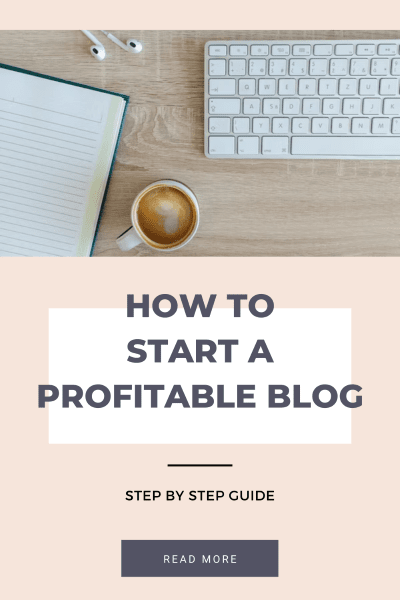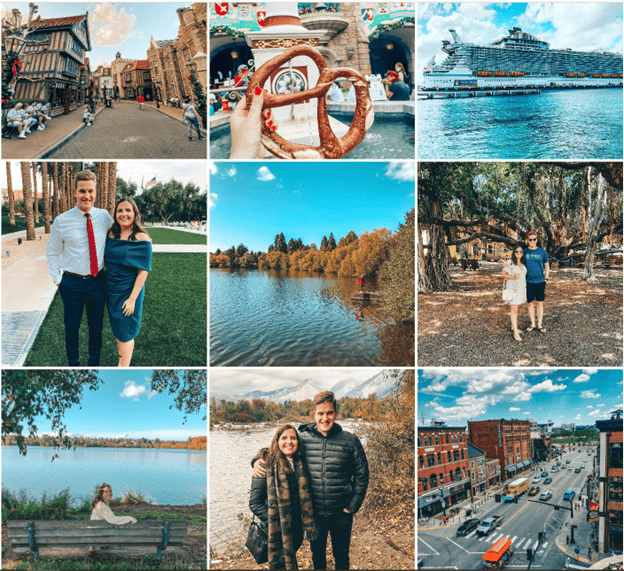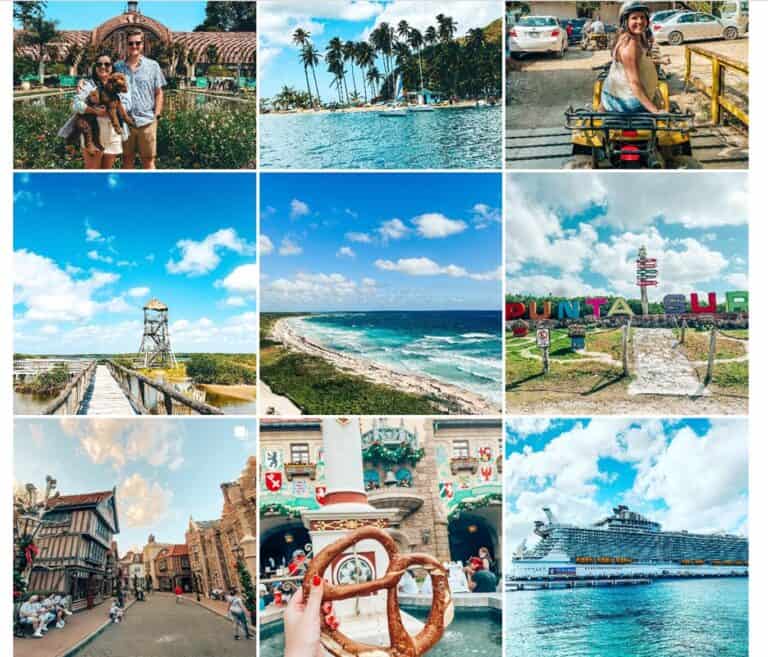How to Start a Travel Blog and Make Money: Step by Step Guide to Creating a Blog
When my good friend shared that she would be starting a blog, I was so excited to share all of my lessons learned and tips with her. I began jotting down everything I learned over the past 2 years of running a travel blog to help her create and grow her blog much faster than I was able to. After writing pages and pages of tips, I decided to turn it into a post all about how to start a travel blog and make money so I could help many more people get started.
I started The Traveling Moore in March of 2020 at the start of the COVID-19 pandemic. Stuck in quarantine and not able to travel for the foreseeable future, I desperately needed a hobby. Starting this blog was a great way to keep myself busy and fuel my love for travel while I was stuck at home.
What started as a hobby with zero pageviews and zero dollars for the first year has turned into a successful side hustle that continues to grow month over month. Running this blog allows me to travel more often and more luxuriously.
I started this blog by googling the best tips, following other bloggers, and teaching myself everything from beginning to end. This guide to how to start a blog and make money will save you the time and stress of researching everything on your own. I share how to create a blog, grow your viewership, and make money. Keep reading for industry best practices, lesson’s I’ve learned, the best investments to make in yourself and your blog.
If you want to see these tips in action, be sure to check out my travel posts.

Some links on this blog are affiliate links, meaning I may earn a commission at no extra cost to you if you make a purchase through them. All opinions are my own, and I only recommend products and services I personally use and believe in. Thanks for your support!
1. Choose your Domain Name & Niche
The very first step to starting a travel blog is choosing your domain name. Many people get stuck on this step, but don’t let that happen to you. Your name should be reflective of your brand and niche.
A niche is the specific area of your topic that you are going to focus on. Having a niche allows your audience to know what content to expect from you and creates a more dedicated audience. As long as you are providing your audience with relevant content for what they expect (ie your niche), they will continue to come back.
A niche should be detailed enough that it’s clear what your focus is, but not so detailed that you can’t write enough content about it. I recommend choosing a narrow niche to start, then you can expand as you grow.
Some examples of niches for travel are: budget travel, cruise travel, family travel, or adventure travel. Some examples for fashion are: budget fashion, designer fashion, tall-girl fashion, or midsize fashion.
Once you have decided on a niche, determine your domain name. When brainstorming your domain, write down a list of words related to your niche and different variations of your name. Try different combinations until you like the domain. If you still aren’t sure what to name your travel blog, your full name is always a safe option.

2. Secure Your Domain Across All Platforms
Now that you have a domain name chosen, secure it across all platforms. Even if you don’t plan to be active on certain platforms, I recommend securing your name in case you change your mind down the road.
Some of the platforms to create an account with your domain are: your website, Instagram, Pinterest, TikTok, and Twitter. If your domain is unavailable on any or all of these platforms, adjust your domain by adding dashes, underscores, or periods (thetravelingmoore, the-traveling-moore, the.traveling,moore, etc). Alternatively, you could revisit your list from step 1 and choose a new name.
3. Select Hosting & Setup WordPress
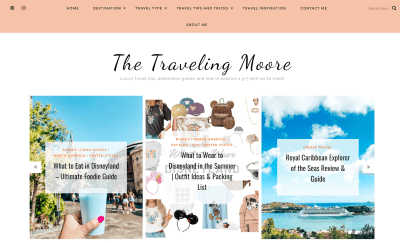
Now that you have your blog named, its time to get it set up! If you plan to monetize your blog, the best website creation platform to use is WordPress.org. Other sites like wordpress.com, Wix, or Squarespace may be easier to use, but will not be scalable with your blog. Spend the upfront time to set up WordPress.org, so you don’t have to shift in the future.
In addition to selecting a platform to build your site, you need to select a host. Web hosting is a service that provides server space for your website. Honestly, I don’t fully understand it technically, but I do know it is very important. This will be your biggest upfront investment and is an important decision. I have my hosting through Bluehost. The platform is easy to use, their customer service is responsive, and it integrates seamlessly with WordPress.
Once you have your WordPress set up, you can begin configuring your blog. The first two steps to creating your site are choosing a theme and downloading relevant plugins.
A theme is important to provide your site with good design, without slowing it down. The Kadence theme on WordPress is one of the most popular options.
Plugins for WordPress
Plugins are ad-ons to your blog that promote functionality without requiring any coding on your end. They can help your blog run smoother, but can also slow it down, so be selective in which you choose.
My top 5 plugins are the following:
- Yoast – This plugin helps simplify SEO by providing tips, guidelines, and automating your site map
- Google Analytics – This is a must-have for tracking your site’s performance
- Smush – Automatically compresses all of your photos to improve page speed
- Social Warfare – allows your posts to be easily shared to all major social media platforms by your audience
- Broken Link Checker – scans your blog for broken links and notifies you when any are found
Getting your blog set up can be confusing and overwhelming. While this touches the surface of what to do, this free course walks you through each step to getting started.
4. Set Up Your Blog’s Business Structure
Next, set up a bit of the backend business structure for your blog. Taking these steps early on will keep everything organized as your blog grows. I know that the business part of blogging is most people’s least favorite part and most of it can wait. However, setting up these few things will save you a ton of time later on.
The first business item to set up is your email. Create an email address through your WordPress and link it to a Gmail inbox to manage. I recommend the email yourname@yourdomain.com. Using a professional email like this will legitimize your business when talking with clients. In addition, using this email for all your blog correspondence will keep everything organized into the same inbox.
The second business item to set up immediately is a business bank account. If you haven’t set up an LLC, you can use your personal SSN in place of the EIN number. Having a dedicated business account will allow you to track your expenses. income, and help with taxes.
5. Determine Content Pillars
Now that you have your blog set up and the backend stuff in order, it’s time to plan out your content. To structure your site, I recommend defining 2-4 content pillars to organize your posts. These content pillars will be the headings on your site and contain similar posts. Each content pillar should be related to your overarching niche.
My blog’s niche is luxury travel, and my content pillars are destination guides, travel tips, and travel inspiration. Another example of content pillars for a fashion brand may be casual outfit ideas, creating a capsule wardrobe, and fashion deals.
Once you have your pillars defined, it should be easy to begin brainstorming post ideas that fit in each bucket. Now, you’re ready to begin writing.
6. Writing Posts with SEO in Mind
SEO (search engine optimization) is the key to driving passive traffic to your site. A successful blog post that ranks on Google will provide a steady flow of visitors to your blog without you having to provide any additional effort. While SEO is super important, it’s also a bit confusing. Below, I’ll break down the beginner tips for SEO if you are simply wondering how to start a travel blog and make money. I’ll also provide a link to a course that was the #1 investment I’ve made in my business.
On Page SEO
On page SEO refers to what you put in your actual blog content that tells google what your post is about so it can share it as a search result when relevant. Through keyword research, you will be able to identify competitive topics or phrases that you can write about that have a high chance of being ranked by google. Then, you can use those phrases in your post so google can understand the topic you are targeting.
The first step to on page SEO is selecting a competitive keyword. My favorite tool for keyword research is Keysearch. It is a paid subscription but is well worth the investment. For the first year of my blog, I tried to leverage free keyword tools and it got me exactly zero hits from google.
In Keysearch, you can type in a potential keyword or phrase, then see the analytics of how competitive it is. The goal is to find a high volume word, with a low score. For example, for this post, I chose the key phrase “how to start a travel blog and make money” because the volume was decent at 200, the score was relatively low at 37 and the topic was very relevant to what I was planning to write.
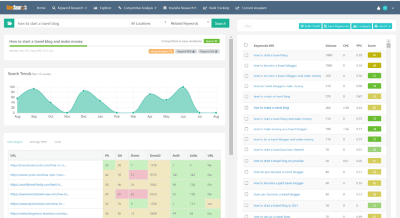
Once you identify your keyword, use it throughout your post and in the title to provide cues to google what the post is about. The Yoast plugin is very helpful at providing guidance of how and where to use the word.
Off Page SEO
Off page SEO refers to the aspects of the blog that make it attractive to google and help it get ranked overall.
One of the most important aspects of SEO is your core web vitals. This includes metrics such as site speed, readability, and mobile-friendliness. You can see analytics of your core web vitals through your google search console profile. Improve your site speed by compressing photos, having a good theme, and limiting the number of plugins you download.
Another aspect of off-page SEO is your domain authority. Domain authority is google’s view of how much of an expert you are on your niche. As you grow your blog, your domain authority will increase, and google will be more “confident” to rank your posts.
One of the best ways to improve your domain authority is by gathering backlinks. Backlinks are links to your website from other websites. This lets google know that other people find your information valuable. While domain authority is important, it takes time to build, so don’t stress about it too much up front.
The Best SEO Course
When I talk to other bloggers and ask their number one regret they have with their blog, 99% of the time, their answer is not getting started with SEO sooner. If you apply SEO in your posts from the beginning, your growth will be much faster and easier.
I tried to learn SEO through blog posts, YouTube videos, and trial and error. While there is a lot of information out there, it did not get me very far. I decided to invest in myself and my business with this course and it changed the trajectory of my blog.
Around six months after taking the course (the amount of time it takes SEO to work), I began ranking on the first page of google and saw a huge influx of pageviews. This increase in views allowed me to apply for ad programs, and I made back my investment into the course through one month of ad revenue.
If you are interested in the course, you can check it out here.
7. Promoting your Blog Posts
In addition to SEO and showing up in search engines, social media is a great way to promote your blog. Social media promotion is especially important in the beginning, as Google takes 6-12 months to begin ranking blog posts.
Most social media won’t directly drive traffic to your blog, but it will create a loyal audience that will lead to higher conversions. Growing your social media also offers opportunities for sponsorship and affiliate marketing on each platform.
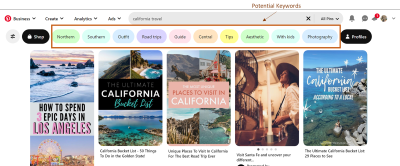
Pinterest drove 100% of my audience for the first year of my blog. Now, it still accounts for around half the traffic. Leveraging Pinterest is a great way to get eyes on your blog and is much quicker than waiting for google. Here are my three tips for leveraging Pinterest for your blog:
- Post Consistently – Pinterest rewards those that use the platform. For each blog post, I post a new pin once a month for the first 10 months followed by another new pin every 6 months
- Use Idea Pins – Idea pins won’t directly drive traffic to your site, but they will grow your audience on the platform which correlates with more views on your pins and more clicks
- Don’t Forget Keyword Research – As with google, keyword research is very important for Pinterest. It’s much more of a search engine than a social media platform. To research keywords, use the suggested search terms within the search box. Use these keywords in your boards, pin titles, and pin descriptions.
Instagram will likely drive very little traffic to your site. However, it is a great way to grow your audience and gain loyal followers that will lead to high conversion rates. Instagram is also very popular with brands for sponsored posts, so you will be able to monetize on the platform. Growing on Instagram in 2022 is tricky due to algorithm changes and the focus on short-form video. To grow on Instagram, here is what I recommend:
- Consistency is Important – The key to growing on Instagram is showing up consistently. Post on stories, reels, and in-feed pictures daily or as often as possible.
- Focus on Reels– In an attempt to compete with TikTok, Instagram has put added focus on reels. To successfully grow on Instagram, you need to prioritize reels. Follow along with reels trends and post at least a few reels per week.
- Hashtags – Hashtags are a great way to drive new viewers to your profile. Focus on hashtags that have views between 50,000 and 500,000 views to show up competitively. Below that many views, you won’t get much traction and above you will be overshadowed by the volume of accounts. Be sure that all of your hashtags are relevant to your niche and your post.
Christina Galbato is a great resource that provides tips for growing and monetizing your Instagram. Follow her on Instagram and check out her blog.
Tik Tok
Although, Tik Tok also won’t drive much traffic to your blog, it’s the easiest platform to grow on in 2022. Any user and any video has the potential to go viral and quickly grow a following. For example, many influencers have shared that it took them 5+ years to grow to an audience over 100k on Instagram and only a handful of months to do the same on TikTok. Admittedly, I haven’t put much focus on my TikTok account. From what I’ve heard, the best way to grow is to post consistently and quantity is sometimes more important than quality when it comes to videos. Sometimes low effort posts will take off, so put yourself out there as much as possible.
8. Monetizing your Blog
Realistically, it will take six months to a year to begin making money from your blog. In the beginning, you should focus on getting your site configured correctly and writing valuable posts. However, you can set yourself up from the beginning to start making passive income once your traffic grows. There are three main ways to monetize your blog:
- Ad Networks: Once you hit certain thresholds of traffic, you can apply for ad networks that will place ads on your site and pay you a small amount per view. The two main networks I recommend are SheMedia and Mediavine. You can apply for SheMedia at 10,000 views and Mediavine at 50,000 views.
- Affiliate Links: Affiliate links are commissionable links to different products you recommend. My top two affiliate programs are LTK and Get Your Guide. LTK is great for linking to retailers such as Amazon, Nordstrom, and other stores (reach out for a referral if you are interested). Get Your Guide is an activity platform, great for the travel niche. You can begin implementing affiliate links immediately, and your income will grow as your blog does.
- Sponsorships: Sponsored posts take a bit more effort on your end. Reach out to some of your favorite brands to get paid to write about their products, destination, or activities. Sponsorships are a great way to sell a bundle of content that can include your social media platforms as well.
Summary of this Guide to How to Start a Travel Blog and Make Money
By now, you should have a decent idea of how to start a travel blog and make money. If you are overwhelmed, here are my three key takeaways:
- Content is King: Write about what you are passionate about and provide value, and a loyal audience will form.
- Invest in Yourself: Take courses to help yourself learn and grow. I can guarantee the investment in yourself will pay off.
- Be Consistent: It can be disheartening to put in a lot of work and not see immediate growth. However, you will be rewarded if you are consistent with your blog posts, and social media activity. SEO takes around 6 months to work and Pinterest around 3, be patient and the views will come.
